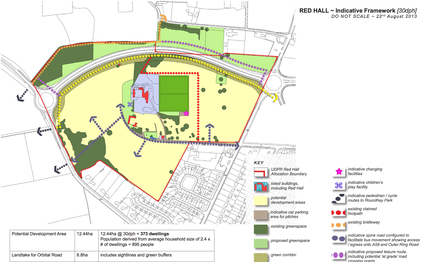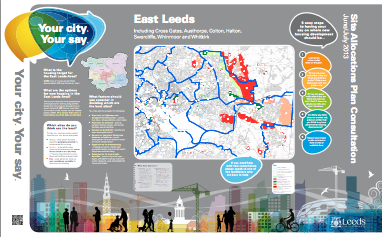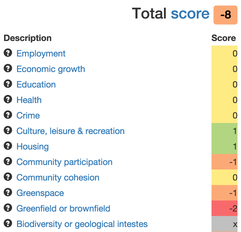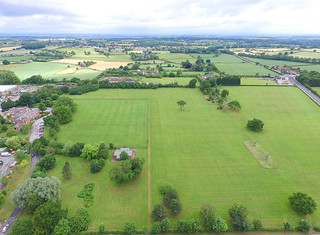
Overview 3 by AceGarp
Earlier this year, we took a deputation to Leeds City Council’s main council meeting, calling for some commitment from Leeds City Council to protect Red Hall Playing Fields, given that it is a green space that serves all of our community’s Parks and Gardens, Amenity Green Space and Playing Provision needs.
The council’s full response is available. It now seems clear that the sale of the fields is intended to raise funds to:
- Relocate the Leeds City Council nurseries to a new facility at Whinmoor Grange
- Partially fund the East Leeds Orbital Road
We do not believe that depriving the local community of the only significant green space it has within walking distance is an acceptable way of funding the move of a nursery that wins awards in spite of its current location, nor is it an appropriate way to fund a road that will pollute the very space it intends to decimate.
Neither do we agree that Roundhay Park is within walking distance of most residents who use the fields – indeed, the response’s quoted distance of 0.66mi (1.02Km) is fanciful – and greater than Core Strategy policy requirements in any case.
Finally, we do not believe that the Council has recognised that these fields are not primarily serving the purpose of playing provision and are capable of being parks and gardens, amenity space and natural greenspace in addition to their stated use. They are for fitness training, dog-walking, kite-flying, informal football, cricket, rugby, blackberry-picking, shared community, running, playing, and living. They are a quieter space in an area soon to be bounded by three A-roads.
The response itself is inaccurate in many respects. Without reproducing the entire document, which you can also read in full, here are the points on which we disagree:
3.2 “Waterlogging” – don’t do yourselves down, council!
3.2 The land allocated for employment use extends to c.11 hectares with c.4 hectares of formal playing pitches within this. This area was previously laid out as 5 playing fields (4 football and 1 rugby league) and a 6 team changing block, but these have not been used since 2006, as a result of ongoing drainage issues that were proving too costly to address in a sustainable way. The playing fields remain in water-logged state for a large part of the year but remain capable of use for informal amenity purposes in dry periods.
The fields are now in use as amenity space all year round.
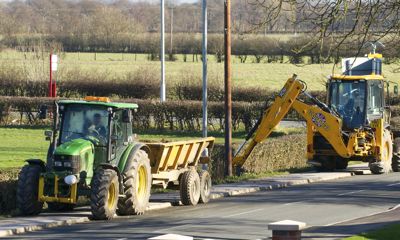
Following meetings between council officials and members of the Friends, the previously-unmaintained ditches have been cleaned out and the historic drainage system now keeps the fields drier for a much larger proportion of the year. Even when the fields are wet they can now only be described as “waterlogged” on the periphery of the A58 and in the area closest to Red Hall Lane. We use them all year. Wellington boots might well be required at times, but that can also be said of Roundhay Park.
Thanks, councillors and officers – you’ve done an excellent job in making the drainage situation better for everyone here without spending a ton of cash. Don’t do yourselves down.
2.3 We formed The Friends in response to a pre-planning document
2.3 The Council understands that the Friends of Red Hall Playing Fields group was formed in 2013 following the completion and occupation of a new build housing site on the southern edge of the playing field land, and the consultation undertaken by the Council on the Site Allocations Plan (Issues and Options June 2013), which proposed a housing allocation for the whole site including the playing fields.
The Council’s understanding is incorrect.
The Friends of Red Hall Playing Fields were formed by residents of Red Hall and Whinmoor in response to the release in 2013 of an informal pre-planning statement as associated materials to a meeting of the Executive Board on 04/09/2013.
No-one knew about the consultation until this document was published and we were taken by surprise by it due to one of our member’s subscriptions to Council notification systems.
3.9 That “long-standing” argument dissected
3.9 The proposition for residential development of the site rather than a business park reflects changes in national planning policy since 2006 that restrict the development of out-of-centre office development. It should also be noted that since the original allocation of the site for a business park, the housing needs of the city have grown significantly in scale, requiring all identified market areas of Leeds to have sufficient land identified to deliver 70,000 new homes by 2028.
The Council likes to use the phrase “long-standing formal development allocation” to say “but this site has always been allocated for development”, as if that decision is in any way relevant over two decades later. However, when it wants to respond to change itself – in this case changing the nature of that development – it does so, and refers to the change in scale of the housing needs of the city.
They’re right – things have changed. There will be 2000 new houses to the east and some hundreds of houses on the old nursery site and on the fields to the north and south of the fields. These were also factors not in play when the “long-standing” allocation was made. They only increase the local need for quality green space provision.
The fields themselves are to be allocated for 50 houses. This represents a mere 1% of the houses to be built in Crossgates and Whinmoor Ward alone.
They’re not going to tell you why this comparatively minuscule allocation is so important, though. It’s because the houses planned for building are to be £500K+ luxury homes – the sort of profit margin build over which developers salivate, and which represent a fat carrot they won’t ignore, while doing little to deal with that change in scale. Meaning that a road that benefits few people actually living here can be funded at the expense of those self-same residents.
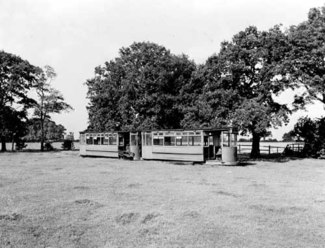 In public hands since 1937
In public hands since 1937
Even if you agreed with the 70,000 homes target – and we, like many, including the Office of National Statistics, who put the projected need at closer to 45,000 by 2028, don’t – it would be more appropriate to respond to this unprecedented surge in building by leaving adequate green space for these future residents rather than indulging in a fire sale of valued and valuable assets.
And if you really want to use the “long-standing” argument – well, Leeds City Council bought the land to use for sporting provision in 1937. These fields have been used for sport since the 19th century and possibly before. They have a history bound up with that of the house. A 20 year-old planning decision, by comparison, is of no historical value.
3.10 2013’s “Blink and you’ll miss it” Consultation
3.10 The principle of residential use across the whole of the Red Hall site was put forward in the Site Allocations (Issues & Options) consultation undertaken in June/July 2013 and is proposed as the allocated land use here through the Site Allocations Plan Publication Draft, with consultation on that plan to be undertaken in the Autumn of this year.
Leeds City Council likes to pat itself on the back that very few comments objecting to the use of this land were received in 2013. However, nobody in the area knew about the consultation. One marketing manager at a meeting with councillors in January 2014 of around 50 residents (all of whom objected to the fields use) said that he “would have been fired” if he had failed to engage with his target audience in this way. A council officer at the same meeting told us that she had seen the bus adverts “Your city, your say” but couldn’t tell from this what they were for.
It is a stretch to equate a failure to engage with the electorate as being indicative of support for loss of amenity.
3.11 Sustainability appraisal scoring errors
3.11 The sustainability impacts of each of the proposed site allocations have been considered in relative terms across the city as a whole. As an existing development allocation Red Hall was assessed as a more sustainable location for development than many others, such as those that would have been in Green Belt or in previously unallocated locations.
There were mistakes made in the sustainability appraisal scoring that led to the allocation of the fields. Even if you charitably accept that the scoring was accurate (it wasn’t), the fields are in the top 3 least sustainable sites out of some 216 allocated for development across the city. If the errors were corrected, the fields would be the single least sustainable site allocated across Leeds.
3.12 Quantum of provision (or: you’re moving this ward’s green space to Harewood)
3.12 The playing fields have been considered in the green space analysis undertaken as part of the Site Allocations Plan and are assumed as being retained or re- provided so there is no overall impact on the quantum of provision. The green space analysis is undertaken at a ward level, as a proxy in the absence of a better alternative, but when assessing specific schemes is also appropriate to consider geographical proximity. Red Hall is in Crossgates & Whinmoor ward but is located at the boundary with two others and is close to Roundhay Park in the Roundhay Ward.
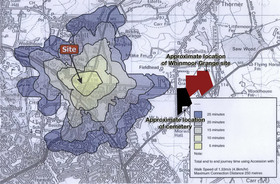
Roundhay Park is not within walking distance. It is not within the distance that is called for in Core Strategy Policy G3. Even if it were, it is over the other side of the Ring Road. That Ring Road has no crossing points. The side of the park facing the Ring Road is inaccessible as it is tree-lined. One must walk into the centre of Roundhay before even the entrance to the park becomes apparent.
When the playing fields are re-provided, they will be 30 minutes’ walk from their current location.
So while we accept that the relevance of the ward-based analysis may vary as you come to the borders of wards, we do not accept that walkable alternatives are already available. Nor will they become available with accessibility improvements. Which is to say nothing of how the decimation of these fields affects people in Red Hall, Whinmoor, and Shadwell.
3.13 No really, Roundhay Park is not accessible from here
3.13 In releasing the nursery and depot part of the site for development, this will become publically accessible with amenity green space, pedestrian and cycle routes designed in to connect with the wider green space network and Public Rights of Way extending into adjoining the countryside. Access through this part of the site will make Roundhay Park more accessible, the edge of it being 0.66 miles away in this direction – the park is currently 1.5 miles away via public highway.
Ah, walkability again. 0.66 miles is 1.06Km. It is not clear in this statement which part of Red Hall Playing Fields can be made to be 0.66 miles away from Roundhay Park. I’ve been sitting here with a measuring tool and a map and I can’t get myself into Roundhay Park from the charitable starting point of the south-westerly portion of the fields. I can just about get myself into the woods surrounding Roundhay Park (at least, were I able to fly) which is hardly a safe space for the young, the elderly, or women walking alone. Nonetheless, even if this somewhat fanciful distance could be achieved, it is still over the 720m distance called for in policy G3 for parks and gardens. It is over the 720m called for by natural green space. It is well over the 480m called for by amenity space.
In any case, the distance quoted is just that: fanciful. And does not take into account the needs of those in Shadwell, Whinmoor, or Red Hall.
Right now, people from these three areas can be on the fields relaxing in 1-10 minutes, just by walking. If you’re proposing that Roundhay Park should be where these people go, you’re on a different planet. That would be a 30 minute trek, even if you could cross the Ring Road safely. Would you send your children there? Or are you happy for them to play on the fields in plain sight? Would you suggest your 70 year-old father with a heart condition go for a quick walk there? Would you plan a walk there with a four year-old? Will you add the two hours round trip to your daily schedule when your dog needs her twice-a-day walk?
The council’s plan, if executed, is to reduce the local community’s ability to meet its day-to-day needs. Effectively saying “you can just use Roundhay Park” is little better than “let them eat cake”.
3.14 These aren’t just playing fields
3.14 The whole Red Hall site will comprise two proposed housing allocations – one for the current nursery and depot site and one for the Area currently in use as playing fields together with the ‘5 acre site’ to the north, which is currently used for storage and composting in association with the nursery.

Bramble picking by AceGarp
We take no issue with the allocation of the nurseries – this is precisely the sort of brownfield re-use that is to be encouraged. As the deputation stated, we are only interested in the publicly-accessible portion of the site – the land that has been in public hands since 1937.
As the deputation said, one of our key issues is that we have little or no access to amenity green space, Parks and Gardens, or natural green space. These playing fields perform those functions too. The use of the fields is incredibly diverse: fitness training, informal sports, family picnics and activities, dog walking and training, extra-mural outings for the disabled, as an area of tranquillity (away from the A58), community engagement, kite flying, blackberry and apple picking.
3.15 Protection of the setting of the historic building
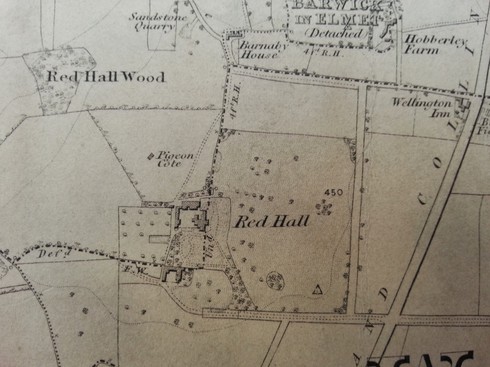 The fields as gardens/hunting area in 1851
The fields as gardens/hunting area in 1851
3.15 The Listed Buildings and land in the ownership and operation of the Rugby Football League will remain unallocated for development.
This doesn’t help with the fact that the fields are the historic parkland to the house. They have been in use as such for more than 200 years, and no special regard for this has been given prior to allocation.
3.16 We really are using this space for more than just sports, you know
3.16 Any development of the site will be required to retain a single area of green space equivalent in size to at least two playing pitches so that re-provision of formal sports use can be made in response to identified need in the wider area. For any pitches not retained on site the provisions of NPPF para. 74 would apply.
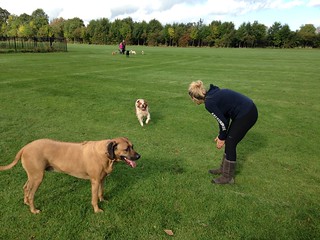
Dog lovers by AceGarp
There are thousands of new houses coming to the east. There are hundreds coming to the west. The fields as they stand are in use for activities mostly other than playing provision. If two pitches are all that is left, and are reinstated as formal playing pitches, we will not be able to use them for the diverse activities these fields currently support, due to both contention with formal activities and pitch wear (the fields might be waterlogged now, but try running around with a small child on them in the middle of February after much of a gruelling season).
This was a key point made by the deputation, and it has not been addressed.
3.17 Preservation of the house’s setting
3.17 Any development would also need to preserve the special architectural or historic interest and setting of the Listed Buildings through buffer zones, landscaping and preservation of important views from Wetherby Road. The allocation of the land for housing would not in itself harm the Listed Buildings on the site, any impact would need to be assessed and judged at planning application stage, with planning guidance given by the Council through the brief for the site.
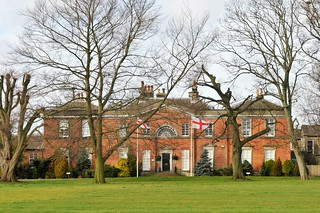
Red Hall Dec by AceGarp
When we spoke to Historic England, they informed us that the Town and Country Planning Act 1990 does indeed require ‘special regard’ to be given to the setting of historical assets before allocation.
A listed building without the historic setting created for it in past times is greatly diminished. In terms of setting and attraction it is largely destroyed. Imagine the mansion house with houses in close proximity. The view in front of the house is of a listed building framed by mature trees in a parkland setting. This creates a pleasing gateway into Leeds which not all cities possess.
3.20 We’re not in agreement that this response addresses our concerns
3.20 In relation to the specific outcomes requested by the Friends of Red Hall Playing Fields, which are noted and understood, it is the Council’s view that the development principles already established for Red Hall through Executive Board and both the existing and proposed land use allocations and associated planning policy requirements for the site go some way towards accommodating the concerns raised.
For the reasons outlined herein, it should be obvious that we are not in agreement. Our own Core Strategy planning policy requirements are not being met at a ward level, and they’re not being met at a local level.
3.23 Volunteer involvement
3.23 Should the Friends of Redhall Playing Field wish to expand their involvement, numerous opportunities exist for them to do so, to be facilitated by the Council. The third sector makes an important contribution to improving parks and green spaces across the city providing an estimated 29,000 volunteer days each year, equivalent to around 109 full-time equivalent staff. This includes over 50 ‘friends of’ groups, over 50 ‘in bloom’ groups, in addition to work placements, community payback, youth rehabilitation and corporate volunteers all of whom conduct practical work on a range of different tasks.
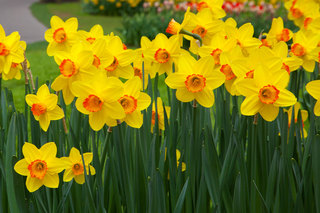
We already clear the fields of litter ourselves. We have bought a small amount of sporting equipment to loan out to people on the fields on dry days. We have already applied for daffodil bulbs to be delivered to be planted – by us – for next season. We have monitored the drainage resulting in an extension of the dry season, and lobbied the council for provision of a bin to the south entrance, which has resulted in less need for us to tidy the pitches ourselves.
We welcome the opportunity to do more – we love this place. If the council has something specific in mind that it feels we’re not already doing, please let us know at the email address to the top right.
3.24 “We roam the fields”
3.24 Furthermore the Fiends of Redhall Playing fields could engage in the Leeds Parks and Green Space Forum. This was established in 2012 and is a voluntary organisation made up of individuals, groups and organisations. They act as a consultation body for decisions being made that affect green spaces as well as influencing policy. They aim to engage more local people in caring for parks and green spaces and to support voluntary groups that care for green spaces in Leeds as well as raise funds for the benefit of parks and green spaces and their users.
It is via this forum we’ve been able to apply for the daffodil bulbs. “The Fiends” have attended most meetings of the Parks and Green Space forum for the last year or more, terrifying the attendees.
